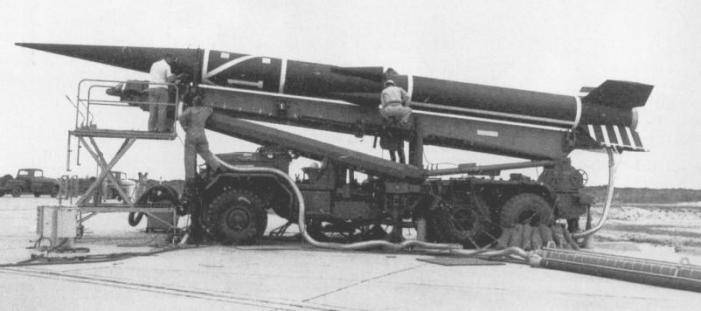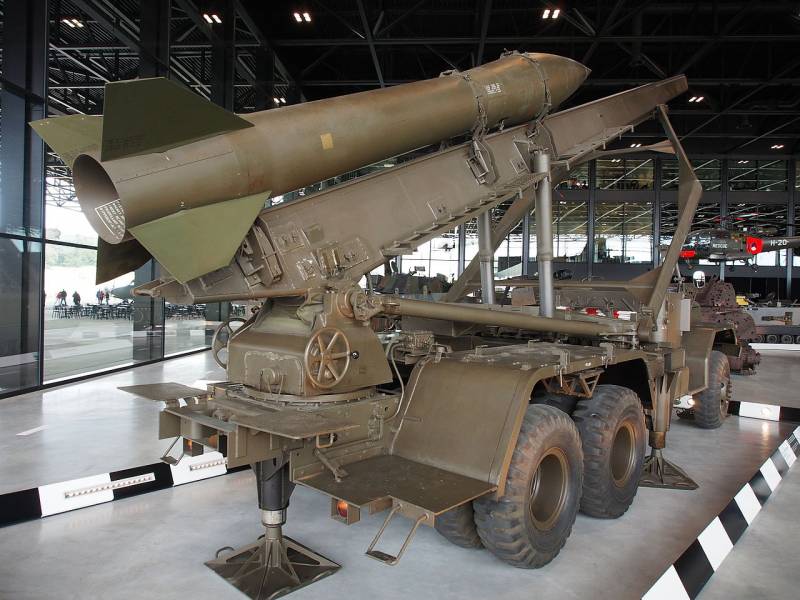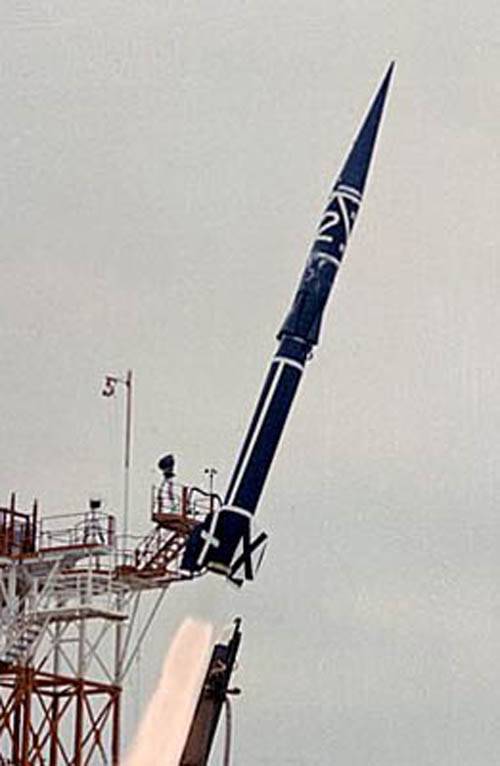McDonnell WS-199D Alpha Draco Experimental Rocket (USA)
By that time, the developers of ballistic missiles faced a serious problem. The head part of the intercontinental missile range on the descending part of the trajectory was to be subjected to excessive mechanical and thermal loads. It was required to protect it from negative factors, ensuring the delivery of a fully operational charge to the target. To search for optimal solutions in this area, it was proposed to develop a special experimental rocket.
New project started in 1957 year. Initially, it was necessary only to study the characteristics of the behavior of combat units in the dense layers of the atmosphere. In the future, it began to be considered as a means of testing the new concept of a shock system. Finally, the issue of using a promising missile as an anti-satellite weapon has been worked out for some time. Remarkable is the fact that the solution of such different tasks did not require cardinal processing of the rocket.

Launch WS-199D on the launcher. Photo Designation-systems.net
Several pilot projects launched by the US Air Force at the end of the 1950s had a similar name. The development of new versions of combat units for ICBMs was to be conducted within the framework of the project with the designation WS-199D (Weapon System 199D). Also, the project was given the "star" name Alpha Draco ("Alpha Dragon"). The contract for the development of the rocket and its subsequent tests received the company McDonnell. Several other organizations were supposed to be involved in the work as subcontractors.
As part of the WS-199D project, they proposed to abandon the “traditional” flight along a ballistic trajectory and work through the concept of BGRV (Boost-glide reentry vehicle - “Combat unit with overclocking and scheduling”). The rocket was planned to include a couple of stages with solid-fuel engines and a head made in the form of a special airframe. It was assumed that the first stage would take the rocket assembly to a predetermined height, the task of the second stage would be acceleration to the design speed, and after its separation the head part will continue horizontal flight independently, up to a complete loss of stored energy and fall into the specified area.
According to the calculations, the second stage should accelerate the glider to a speed of more M = 5. During the flight, the speed could noticeably decrease, but still remain sufficient to form a lifting force. Such indicators of speed allow us to classify the head of the WS-199D rocket into the category of hypersonic aircraft. Moreover, it turns out to be one of the first models of its class both in the United States and in the world.
Using a rocket with such principles of operation, scientists could investigate the behavior of the airframe at high speeds in dense layers of the atmosphere. In addition, it was possible to study the possibility of using a BGRV missile as an independent weapon. In both cases, the Alpha Draco project was supposed to give practical results.
The WS-199D project was experimental in nature and not too much time was allotted for its implementation. To speed up the development, construction and testing of new technology, McDonnell decided to make extensive use of available components of various types borrowed from serial equipment. So, it was planned to take engines for two stages from rockets MGM-29 Sergeant and Nike-Hercules. The existing model controls are provided by Honeywell.
The finished Alpha Dragon rocket had a fairly simple design. Assembled, it was a cylindrical product with a long conical head fairing and X-shaped rudders on the tail of the first stage. The tail of the second stage was distinguished by the presence of several curved cones. Almost all the internal volumes of the two stages were given for the installation of solid fuel engines. The small instrument compartments of the steps contained the simplest controls.

Preparing to start. Photo of Air Force Space and Missile Museum / аfspacemuseum.org
The main element of the first stage was a solid Thiokol TX-20 engine from Sergeant rocket. It had a steel case with a length of 5,9 m and a diameter of 7,9 m. The fuel charge burned out for 29 s, creating 21,7 tf thrust. The second stage was completed with a smaller TX-30 engine from the same manufacturer. This product, also taken from one of the serial missiles, developed a thrust near 5,6 tf for 37 s. In accordance with the concept of BGRV, a more powerful first-stage engine was supposed to provide a rocket lift to a predetermined height, and the second stage was responsible for the acceleration of the test head.
According to known data, a planning aircraft of unusual design was located under the conical fairing of the WS-199D rocket. According to the calculations of the authors of the project, at the beginning of an independent flight he had to have a speed of the order of M = 5, which placed special demands on the design. It had to be different mechanical strength, and in addition, to withstand high temperature loads.
According to different sources, the payload of the Alpha Draco rocket was similar to a cone with a rounded head and was built in accordance with the ideas of the lifting body. The contours of the conical hull were defined in such a way that during high-speed flight they created a lifting force. To protect internal devices from high temperatures, it was proposed to use modern heat-resistant alloys, ablative coating and other promising solutions. The most effective way to protect could be developed and find application in future projects.
The WS-199D project involved the use of fairly simple controls. An inertial navigation system combined with autopilot was present on board the rocket. On the basis of data on the position of the rocket in space, commands for steering gears were developed. In this case, flight control continued only until the end of the second stage. After its separation, the head part turned into an uncontrolled planning flight. However, its board was attended by its own equipment - for collecting and transmitting data.
The Alpha Draco product assembly had a length slightly more than 14 m. The maximum case diameter was determined by the dimensions of the TX-20 engine and was 790 mm. The scale of the stabilizers - 2,16 m. Mass, according to various sources, exceeded 4,5-5 t.
The experimental rocket was supposed to launch from a ground-based launcher from the MGR-1 Honest John series. On the triaxial wheeled chassis, there was an open cab and a lifting beam guide. Before the launch of the rocket, such a machine had to be hung out on jacks and raise the guide to a given angle. Further, the engine was launched, and the rocket began its flight.

MGR-1 Honest John missile system, the launcher of which was used with the WS-199D rocket. Photo of Wikimedia Commons
The development of the WS-199D project was completed by the end of 1958, after which McDonnell and its subcontractors began preparing for future trials. All new units were manufactured, and serial parts were also received. Of them collected several experienced missiles, which in the near future should be sent to the range at Cape Canaveral. For the test launches the launch pad LC-10 was allocated. Flights were to take place over the Atlantic Ocean.
The standard flight program for the Alpha Dragon rocket looked as follows. With the help of the launch guide, the rocket was raised to the maximum permissible elevation angle. At the operator's command, the first stage engine was ignited. For half a minute of work, he raised the rocket to a height of 12800 m. Then the first stage was dropped, and in addition, the rocket leaned forward along the flight. After reaching the required angle, the engine of the second stage was started. With it, WS-199D had to rise to a height of 30500 m and accelerate to speeds of at least M = 5. Next, the spent second stage was separated from the head part, the fairing was dropped. The planning aircraft began independent flight. According to calculations, he could retire to 380-400 km from the starting point.
February 16 1959, the specialists of the Air Force Air Force and the contractor companies conducted the first test launch of a new experimental rocket. The WS-199D product successfully reached the specified height and gained the required speed, after which the scheduling unit dropped. Descending from a height of more than 30 km, the latter showed the flight range above the calculated one. The glider fell into the water at a distance of 415 km from the starting point. All systems worked properly, and the necessary information was collected. The first test run was considered successful.
Exactly a month later, the launch of the second rocket took place. It is possible that prior to these tests, the existing Alpha Draco design was finalized, but there is no detailed information on this. The new launch was also successful, but this time the rocket showed less high range performance. The point of its fall into the water was in 393 km from the launch site.
April 27 held the third and final test run. The first stage of the rocket worked properly and raised it to a predetermined height. After adjusting, the second stage engine was turned on, but control systems failed. The rocket took the wrong course. A few seconds after that, in order to avoid negative consequences, the testers were forced to activate the missile self-destruct. The flight lasted less than a minute, and during this time the rocket did not have time to move far from the launch pad.
Of the three launches, only two were successful, and the test results were considered satisfactory. Even during the two flights, the specialists managed to collect a considerable amount of information about the operation of various systems in difficult conditions, and also to test in practice some new solutions. Resume testing was no longer planned, because now the designers of various organizations had to deal with the introduction of new experience.

Alpha Draco at the time of launch. Photo Space.skyrocket.de
Analysis of the test results showed that BGRV systems, in general, are of interest from the point of view of military use, but so far they cannot find practical application. This concept needed additional research, testing and experimentation. Only after that was it possible to start developing a full-fledged planning combat unit for promising ballistic missiles.
At the same time, certain developments on the project McDonnell WS-199D Alpha Draco could be implemented now. So, in practice, it was shown that the conical shape of the combat unit allows to obtain an aerodynamic quality of at least 3-3,5 units, and this made it possible to increase the flight range. In addition, it was possible to use means of thermal protection tested in flight. They were to be used in the field of strategic weapons, as well as in the emerging cosmonautics.
The theoretical and practical developments of the WS-199D project were first used to create the promising intercontinental ballistic missile LGM-30 Minuteman. Taking into account the experience of Alpha Dragon, warheads were built for such a rocket. In the future, these developments were developed and already in a new form were used in all subsequent projects of strategic missile weapons.
Already in the late fifties, the test results of an aircraft with a carrying case became interested in NASA. Soon this organization launched its own program, the purpose of which was to study in more detail the non-standard architecture of aircraft. Since the early sixties, NASA and related aircraft building organizations have built and tested various unusual aircraft. This program had a significant impact on further developments in the field of returnable spacecraft.
According to some reports, the Alpha Draco rocket, like other developments under the cipher WS-199, has been considered from time to time as a promising weapon for fighting spacecraft in low orbits. However, there is no detailed information about this. Moreover, the known information on the characteristics of this product allows us to doubt the very possibility of its use for such purposes. The fact is that the characteristics of the engines of the two stages could be insufficient for taking the rocket or its combat unit to the required height of hundreds of kilometers.
Work on the pilot project McDonnell WS-199D Alpha Draco lasted less than two years and ended with only three launches of experienced missiles. However, despite the short duration, they ended with the collection of a large amount of information about promising technologies and solutions suitable for use in creating new rocket technology. Some of the ideas of this project are still used in various fields and successfully cope with the solution of the tasks.
On the materials of the sites:
http://designation-systems.net/
https://globalsecurity.org/
http://alternatewars.com/
http://militaryparitet.com/
http://space.skyrocket.de/
Information